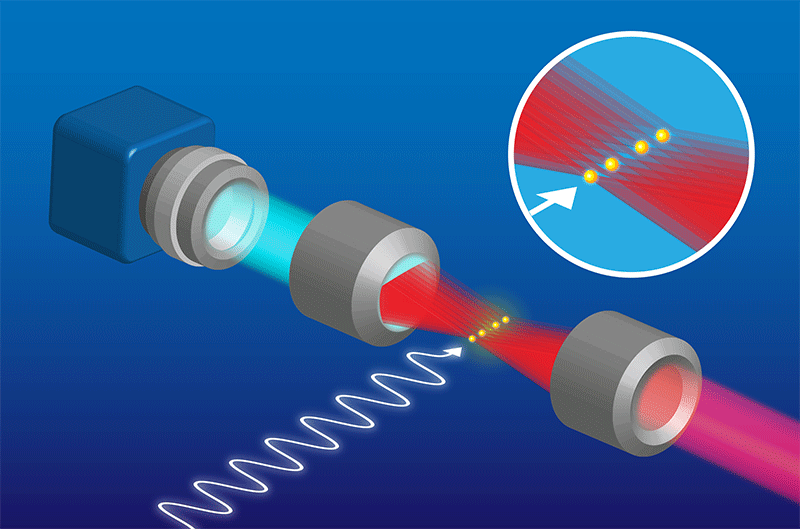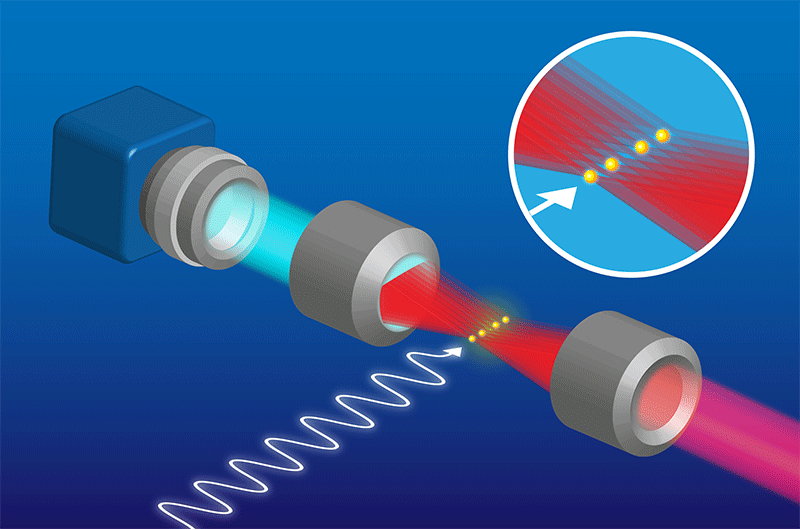“Tweezer Clock” Offers New Possibilities in Timekeeping
Better clocks are always in demand. That’s because precision timekeeping can be leveraged for so many applications, ranging from navigation and communication networks to radio astronomy and searches for beyond-standard-model physics. Today’s most precise clocks are optical clocks with trapped atoms, which use the optical frequency of an electron transitioning between two atomic states as the timebase. Each cycle of this frequency provides a very precise “tick” of the clock. Among advanced optical atomic clocks, researchers have largely focused on two types: those that probe an electron of just a single trapped atom (specifically, an ion) and those that probe the electrons of many atoms trapped in interfering laser beams (an optical lattice.) Now, two groups have introduced a third type of trapped-atom optical clock into the timekeeping landscape [1, 2]. The new “tweezer clock” comprises many separate optical traps, known as optical tweezers, but each trap contains only one atom. This new architecture captures some of the best features of the single-atom and optical lattice approaches.
The primary advantages of basing a clock on a single ion are that the particle can be precisely manipulated and isolated from the outside world, which together limit effects that distort the electron’s ticking rate (and thus the clock’s accuracy). However, the precision of such clocks is fundamentally limited by the quantum uncertainty of the atom’s state [3]. With optical lattice clocks, this so-called quantum projection noise can be averaged away by probing the frequency of thousands (or more) atoms at once. Compared to the single-atom case, the noise drops by the square root of the number of atoms, leading to greater precision within a given measurement time. The downside of the lattice approach is that the atoms in the lattice can potentially interact with each other, perturbing the electron ticking rate. Typically, one also loses the ability to control or read out the states of individual atoms [4] (see 5 March 2018 Viewpoint). These features would otherwise be useful for improving clock operation and performance.
The optical tweezer clock offers an intriguing compromise between the single-ion and lattice approaches. An optical tweezer is a tightly focused laser beam that can pull atoms (or other small objects) to its narrowest point. Manuel Endres at the California Institute of Technology, Pasadena, and colleagues developed an experimental clock that uses a 1D array of 81 such tweezers, with about half of these containing a single atom. This number of atoms is high enough to reduce quantum noise by about a factor of 6 compared with the single-atom case. The atoms are also well spaced (by several micrometers), suppressing disruptive atomic interactions. What’s more, the clock offers single-particle read out for each tweezer.
Setting up the new clock involves a few steps. The researchers begin by laser cooling a gas of strontium, an atomic species whose electronic structure is well suited to an optical clock. They then load the cold atoms into the array of nearly identical optical tweezers, which are formed by passing a laser through an acousto-optic deflector and an objective lens (Fig. 1). The loading process doesn’t, however, guarantee one atom per tweezer—some have zero, while others have multiple atoms. The researchers therefore use an additional laser to kick out atoms where there’s an excess, leaving empty tweezers unfilled. Finally, the team “interrogates” each tweezer’s atom. This process entails tuning a laser frequency until the atom is excited and its fluorescence can be detected (read out) with a camera.
Following a recipe reported previously [5], Endres’ group employs a nondestructive read-out scheme that enables them to interrogate and read out the atoms multiple times before loss mechanisms require reloading a new group of atoms into the tweezers. Thanks to the single-particle read-out capability of their setup, they are able to measure small shifts in the clock transition that arise from the tweezer’s optical field [6] and to determine how these shifts vary from tweezer to tweezer. Similar measurements could be used to detect electromagnetic field gradients or other inhomogeneities that perturb the clock. The group is also able to characterize the clock's stability. Although they find a value that is more than an order of magnitude worse than for the best atomic clocks, improvements will be possible with a less noisy clock laser. Further progress will likely come from using larger arrays and making quantum enhancements.
In a separate paper reported in October, Adam Kaufman and collaborators at JILA and the University of Colorado Boulder, also demonstrated a tweezer clock using strontium [2]. Many of the essential details in their clock were similar. But they focused on a smaller array (roughly five atoms). They also employed an advanced cavity-stabilized clock laser, enabling coherence-preserving atomic interrogations of up to four seconds—an impressive number not only for a tweezer clock but for any optical clock. Under these conditions, the team achieved greater frequency stability than the Endres group, and the stability was limited entirely by projection noise.
A goal for the future is to combine single-particle read out with single-particle interrogation and control. Such control could make the optical tweezer clock a convenient platform for multi-ensemble protocols that may offer big boosts in clock performance, including extended interrogation schemes [7] and zero-dead-time configurations [8]. Optical tweezer arrays provide an emerging platform for exploring quantum computation and simulation as well as quantum-enhanced measurements. Advances in any one of these areas will undoubtedly feed into the others. For example, entanglement-enhanced measurements may translate nicely to an optical tweezer clock, offering advances in clock precision.
Scaling the tweezer clock up to larger atom numbers is an important next step in order to reach the lower quantum-noise levels available with lattice clocks. Today’s lattice clocks typically employ thousands of atoms or more and reaching this number with tweezer clocks will be a challenge, in part because of technical limitations on the laser power required to form the tweezers. But the 1D tweezer clock now demonstrated can be naturally scaled to a 2D array, while still preserving the benefits of single-particle read out. Given all the possibilities for future enhancements to the tweezer clock, it’s clear that this new approach to timekeeping and quantum control has an intriguing future.
This research is published in Physical Review X and Science.
References
- I. S. Madjarov, A. Cooper, A. L. Shaw, J. P. Covey, V. Schkolnik, T. H. Yoon, J. R. Williams, and M. Endres, “An atomic-array optical clock with single-atom readout,” Phys. Rev. X 9, 041052 (2019).
- M. A. Norcia, A. W. Young, W. J. Eckner, E. Oelker, J. Ye, and A. M. Kaufman, “Seconds-scale coherence on an optical clock transition in a tweezer array,” Science 366, 93 (2019).
- W. M. Itano, J. C. Bergquist, J. J. Bollinger, J. M. Gilligan, D. J. Heinzen, F. L. Moore, M. G. Raizen, and D. J. Wineland, “Quantum projection noise: Population fluctuations in two-level systems,” Phys. Rev. A 47, 3554 (1993).
- G. E. Marti, R. B. Hutson, A. Goban, S. L. Campbell, N. Poli, and J. Ye, “Imaging optical frequencies with 100 𝜇Hz precision and 1.1 𝜇m resolution,” Phys. Rev. Lett. 120, 103201 (2018).
- J. P. Covey, I. S. Madjarov, A. Cooper, and M. Endres, “2000-times repeated imaging of strontium atoms in clock-magic tweezer arrays,” Phys. Rev. Lett. 122, 173201 (2019).
- H. Katori, M. Takamoto, V. G. Pal’chikov, and V. D. Ovsiannikov, “Ultrastable optical clock with neutral atoms in an engineered light shift trap,” Phys. Rev. Lett. 91, 173005 (2003).
- D. B. Hume and D. R. Leibrandt, “Probing beyond the laser coherence time in optical clock comparisons,” Phys. Rev. A 93, 032138 (2016).
- M. Schioppo et al., “Ultrastable optical clock with two cold-atom ensembles,” Nat. Photon. 11, 48 (2016).





